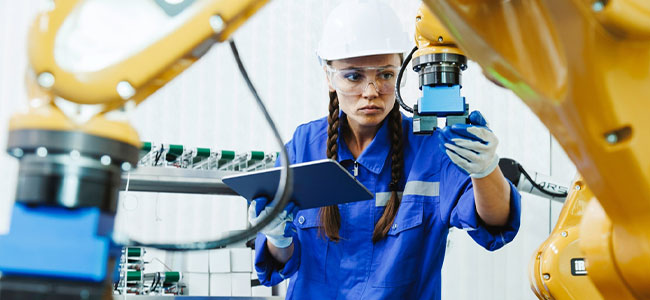
6 Ways Cobots Are Elevating Factory Safety Standards
While machines at their core, cobots represent a distinct chapter in robotic evolution, fusing mechanical prowess and interpersonal functionality.
- By Eric Whitley
- Nov 17, 2023
In decades past, the rigid, mechanical movements of traditional robots were confined to segregated sectors in factories. Their function was fixed, and their interactions were limited. Enter the cobot era, named for robots designed not for isolation but integration. Their very essence signals an industry pivot towards human-centric operations and safety.
Safety in factories is crucial, especially given rising safety concerns in today's fast-evolving landscape. Rapid technological advancements must always adhere to stringent safety regulations, as mishaps have dual implications: immediate physical repercussions and long-term operational setbacks.
Understanding Cobots
Cobots represent a distinct chapter in robotic evolution. They are a fusion of mechanical prowess and interpersonal functionality. While machines at their core, their primary objective is to complement — not replace — human effort. Their design speaks of empathy, intuitiveness and collaboration.
The traditional robot was an island: secluded, predictable and rigid. In contrast, cobots seamlessly integrate into human environments. Their operational ethos is centered on adaptability, safety and intuitive interaction, showcasing a paradigm shift in robotic applications.
1. Safety by Design: Core Attributes
Safety is foundational to cobots’ design. They feature systems like torque sensors, vision mechanisms and intuitive algorithms that prioritize human interaction. Their autonomous function is a testament to their trustworthiness.
Every aspect of a cobot is meticulously crafted. They work quickly while prioritizing human comfort. Soft materials and curvilinear designs further minimize injury risks. Simply put, they are built to coexist with human workers.
2. Sensory Proficiency
Cobots aren’t just executors but keen observers. Equipped with sophisticated sensors, they perceive, evaluate and adapt to their surroundings. This ability to respond dynamically ensures optimal safety in evolving environments.
Sensors allow cobots to analyze and calibrate at any given moment. Their real-time feedback mechanisms coupled with object differentiation capabilities keep them steps ahead of potential hazards. Plus, proactive collision prediction roots out dangers before they materialize.
3. Symbiotic Operations
Created to be allies to humans, they bridge operational gaps, liberating workers from high-risk tasks. Cobots’ design still includes mechanized efficiency that maintains a synergistic relationship with workers on the shop floor.
Integration is at the heart of cobots. They don’t merely coexist but actively collaborate within shared spaces. When they transition tasks, it’s closer to a dance than to a mechanical handoff. Every interaction refines their operation, ensuring a smoother, safer workflow.
4. Alleviating Repetitive Strain
In the fight against workplace monotony, cobots are the vanguard. They tackle repetitive tasks with unmatched consistency, safeguarding humans from potential strain-induced injuries. Their deployment is the next step toward operational efficiency.
Unlike their human counterparts, cobots are unwavering in their precision. They are immune to fatigue and its resultant errors. This constancy is a bulwark against potential risks arising from human inconsistencies.
5. Dynamic Training and Versatility
The brilliance of cobots lies in their adaptability. User-friendly interfaces make programming them an intuitive task, not a technical challenge. This ease of redefinition ensures that shifts in tasks or priorities don’t compromise established safety parameters.
The cobots’ ability to swiftly adapt is as much an operational asset as it is a safety pillar. Their rapid reprogramming capabilities mean they can be repurposed on demand. Such flexibility ensures they remain assets — and not liabilities — in the fast-changing digital factory landscape.
6. Harmonizing Safety Protocols
Cobots can further safety standards rather than disrupting them. They are designed for easy assimilation into established safety frameworks. From respecting designated paths to being responsive to alarms, they uphold the safety protocols of any given environment.
Cobots come with built-in safety reflexes. They instantly halt the detection of anomalies, ensuring minimal risk. Their resumption post-interruption is calibrated, eliminating abrupt misalignments. Respecting demarcated zones is another useful facet of their ingrained behavior.
The Future of Cobots in Safety Enhancement
The cobot story is as compelling as it is progressive. Their forthcoming versions will likely be equipped with even more refined sensors, advanced decision matrices and nuanced learning capabilities. They will adapt to complex tasks and proactively predict and mitigate safety challenges.
The future isn't limited to advancements in robotics alone. Collaboration with fields like artificial intelligence, data analytics and biomechanics will further enhance cobot capabilities. This interdisciplinary approach will lead to cobots that can anticipate human needs, recognize potential risks and proactively institute corrective actions.
Beyond functionality and safety, the manufacturing industry is gradually veering towards sustainable and ethical robot deployment. Future cobots will be designed with a keen focus on environmental impact, energy consumption and even ethical considerations regarding human-robot interactions.
The ripple effects of cobot evolution will be felt across the entirety of industrial sectors. As their capabilities sharpen and as they become central figures in factory ecosystems, safety benchmarks will transform an industrial transformation journey. Cobots, in their advanced iterations, will be both the guardians and the benchmarks of this enhanced safety ethos.
Conclusion
The emergence of cobots is more than just a technological evolution. It’s a paradigm shift, indicating an industry fervently focused on human well-being. Their growing popularity illustrates both our technological prowess and an unwavering commitment to factory safety.
Cobots symbolize a harmonious blend of human intuition with machine precision, bridging gaps and elevating standards. The rapid strides in technology highlight a broader message. Industries are not only adapting but are also taking proactive steps to create workplaces where innovation coexists with safety.